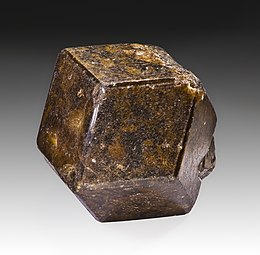Andradite
| Andradite [Adr] | |
|---|---|
 Single crystal (4.2 cm) – Diakon, Nioro du Sahel Circle, Kayes Region, Mali | |
| General | |
| Category | Garnet group |
| Formula (repeating unit) | Ca3Fe2(SiO4)3 |
| IMA symbol | Adr[1] |
| Strunz classification | 9.AD.25 |
| Crystal system | Cubic |
| Crystal class | Hexoctahedral (m3m) H-M symbol: (4/m 3 2/m) |
| Space group | Ia3d |
| Unit cell | a = 12.056 Å; Z = 8 |
| Identification | |
| Color | Yellow, greenish yellow to emerald-green, dark green; brown, brownish red, brownish yellow; grayish black, black; may be sectored |
| Crystal habit | Commonly well-crystallized dodecahedra, trapezohedra, or combinations, also granular to massive |
| Cleavage | none |
| Fracture | conchoidal to uneven |
| Tenacity | Brittle |
| Mohs scale hardness | 6.5 to 7 |
| Luster | Adamantine to resinous, dull |
| Streak | White |
| Diaphaneity | Transparent to translucent |
| Specific gravity | 3.859 calculated; 3.8–3.9 measured |
| Optical properties | Isotropic, typically weakly anisotropic |
| Refractive index | n = 1.887 |
| Absorption spectra | demantoid – 440 nm band or complete absorption at 440 nm and below, may also have lines at 618, 634, 685, 690 nm[2] |
| References | [2][3][4][5] |
| Major varieties | |
| Demantoid | transparent light to dark green to yellow-green |
| Melanite | opaque black |
| Topazolite | transparent to translucent yellow, may show chatoyancy |
Andradite is a mineral species of the garnet group. It is a nesosilicate, with formula Ca3Fe2Si3O12.
Andradite includes three varieties:
- Melanite: Black in color due to limited substitution of titanium for iron. Also known as "titanian andradite". Forms a solid solution with morimotoite and schorlomite depending on titanium and iron content.[6]
- Demantoid: Vivid green in color, one of the most valuable and rare stones in the gemological world.[7]
- Topazolite: Yellow-green in color and sometimes of high enough quality to be cut into a faceted gemstone, it is rarer than demantoid.[7]
It was first described in 1868 for an occurrence in Drammen, Buskerud, Norway.[3][4][7] Andradite was named after the Brazilian statesman, naturalist, professor and poet José Bonifácio de Andrada e Silva (1763–1838).[3][7]
Occurrence
It occurs in skarns developed in contact metamorphosed impure limestones or calcic igneous rocks; in chlorite schists and serpentinites and in alkalic igneous rocks (typically titaniferous). Associated minerals include vesuvianite, chlorite, epidote, spinel, calcite, dolomite and magnetite.[3] It is found in Iran, Italy, the Ural Mountains of Russia, Arizona and California and in Dnipropetrovsk Oblast in Ukraine.
Like the other garnets, andradite crystallizes in the cubic space group [[Ia3d]], with unit-cell parameter of 12.051 Å at 100 K.[8]
The spin structure of andradite contains two mutually canted equivalent antiferromagnetic sublattices[9] below the Néel temperature (TN=11 K[10]).
-
Black crystals of andradite: melanite
See also
References
- ^ Warr, L.N. (2021). "IMA–CNMNC approved mineral symbols". Mineralogical Magazine. 85 (3): 291–320. Bibcode:2021MinM...85..291W. doi:10.1180/mgm.2021.43. S2CID 235729616.
- ^ a b Gemological Institute of America, GIA Gem Reference Guide 1995, ISBN 0-87311-019-6
- ^ a b c d Handbook of Mineralogy
- ^ a b Andradite, Mindat.org
- ^ Webmineral data
- ^ Melanite, Mindat.org
- ^ a b c d Grande, Lance; Augustyn, Allison (2009). Gems and Gemstones: Timeless Natural Beauty of the Mineral World. University of Chicago Press. pp. 188–91. ISBN 978-0-226-30511-0.
- ^ Thomas Armbruster and Charles A. Geiger (1993): "Andradite crystal chemistry, dynamic X-site disorder and structural strain in silicate garnets." European Journal of Mineralogy v. 5, no. 1, p. 59-71.
- ^ Danylo Zherebetskyy (2010). Quantum mechanical first principles calculations of the electronic and magnetic structure of Fe-bearing rock-forming silicates, PhD Thesis, Universal Publishers/Dissertation.com, Boca Raton, Florida, USA, p. 136. ISBN 1-59942-316-2.
- ^ Enver Murad (1984): "Magnetic ordering in andradite." American Mineralogist 69, no. 7-8; pp. 722–24.
External links
![]() Media related to Andradite at Wikimedia Commons
Media related to Andradite at Wikimedia Commons

